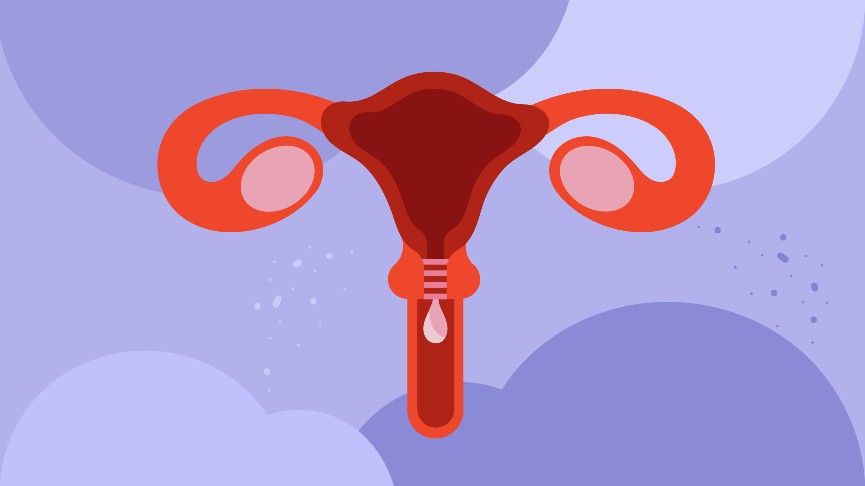What are Cervical Polyps?

This article was medically fact-checked by Consultant Obstetrician and Gynaecologist Dr. Shree Datta.
The cervix is an incredible organ.
It serves as the gateway between the vagina and the uterus, it allows sperm to come in, or keeps it out, period blood flows through it, and it helps to keep the uterus safe from infection, especially during pregnancy. Along with many other incredible abilities.
Shaped like a donut, the cervix changes throughout your menstrual cycle and pregnancy, and secretes mucus to help you track these changes.
Like any organ, however, the cervix’s health is susceptible to conditions like cervical cancer, a friable cervix, and cervical polyps.
What are Cervical Polyps?
Polyps are small clump of cells that form together to create bulb-like lumps. They are typically benign, or not cancerous, and occur in about 2-5% of people with uteruses. They can also occur elsewhere in the body.
Polyps tend to be red, purple or greyish-white. People with polyps may have just one, or they could have multiple ones clustered together.
There are two main types of cervical polyps, endocervical, and ectocervical. The most common are endocervical polyps, which grow from the cervical glands in the endocervix, or opening of the uterus. These are most common in people who have not yet hit menopause. Ectocervical polyps, on the other hand, grow from the outer surface layer cervical cells around the ectocervix, where the cervix meets the vagina.
They are usually found during a routine pelvic exam or gynecological examination.
The biggest risk of cervical polyps is that they can look similar to cancerous lumps. If you do have them removed, your provider will typically send them to the lab for analysis. Only 0.2%-1.5% of cases are malignant and indicative of disease or cancerous. These occur most often in people who are postmenopausal.
Who Gets Cervical Polyps?
While anyone with a cervix can develop cervical polyps, there are certain risk factors that can increase someone’s chance.
Cervical polyps are more common in people who are over the age of twenty, and in people who have had children.
People with a history of cervical polyps do have a greater chance of developing more, although they won’t necessarily grow back in the same spot. About one in eight people who have had cervical polyps removed, will have a recurrence.
What Causes Cervical Polyps?
It’s difficult to know the exact cause of cervical polyps, but there certainly are some factors that can contribute to their development.
- People who experience chronic inflammation, especially in the cervical region.
- Clogged blood vessels in the cervix.
- Cervical infection, and people who have chronic yeast infections.
- Some researchers believe polyps can be caused by a hormonal imbalance or change that causes someone’s estrogen levels to be off. Like an estrogen dip after menopause.
- People with a history or current Sexually Transmitted Infection like herpes or HPV.
- People who have polyps elsewhere – for example, in the womb or nasal polyps
What are The Symptoms of Cervical Polyps?
Oftentimes someone with cervical polyps experiences little to no symptoms or pain. Even if they do show symptoms, they are often nonspecific, and require further examination in order to diagnose.
Here are some common symptoms of cervical polyps:
- Bleeding after penetration with a penis or sex toy.
- Having a heavier period than normal, with possible bleeding or spotting between periods.
- If an infection is present, someone may have abnormal discharge. This discharge may be yellow or white, and off-smelling.
- Bleeding in between periods
- Heavier or longer periods
Diagnosis and Treatment of Cervical Polyps
If you show symptoms of cervical polyps, or your doctor suspects you may have them, they will first need to diagnose you. This is typically done with a pelvic exam, along with an abdominal or transvaginal ultrasound. In some cases, a provider may do a simple procedure called a hysteroscopy, which allows them to look inside your uterus, through a sort of telescope device that transmits images of your uterus onto a screen.
Oftentimes cervical polyps require no treatment. Sometimes they even fall off on their own, especially during your period, or from penetrative sex.
Your provider may not remove them unless they are very big, bleed, or are unusual looking. They will also need to be removed, if they suspect infection or cancerous cells.
Cervical polyps can cause issues if they grow big enough to block the passage from the cervix to vagina. Can also become inflamed or infected, which can make them uncomfortable, or increase abnormal bleeding.
If your provider finds cervical polyps during an examination, it’s most likely nothing to worry about. If you do need to have them removed, it’s typically done with a simple in-office procedure. Your doctor may need to cauterize the polyp site after removal in order to prevent recurrence and bleeding.
For large polyps or if someone has a lot of them, removal may require a surgical procedure under general anesthesia.We may also need to request an ultrasound of the womb to exclude more polyps in the womb. We may also take a smear to check the cells on your cervix are normal.
Ask your doctor if you suspect you might have cervical polyps or are experiencing any of the symptoms listed above.
Facts Checked By:

Dr. Shree Datta is a Consultant Obstetrician and Gynaecologist in London, specialising in women’s health including all menstrual problems such as fibroids and endometriosis. Dr. Shree is a keen advocate for patient choice, having written numerous articles and books to promote patient and clinician information. Her vision resonates with INTIMINA, with the common goals of demystifying periods and delivering the best possible care to her patients.
Article written by:

Natasha (she/her) is a full-spectrum doula and health+wellness copywriter. Her work focuses on deconstructing the shame, stigma, and barriers people carry around birth, sex, health, and beyond, to help people navigate through their lives with more education and empowerment. You can connect with Natasha on IG @natasha.s.weiss.


